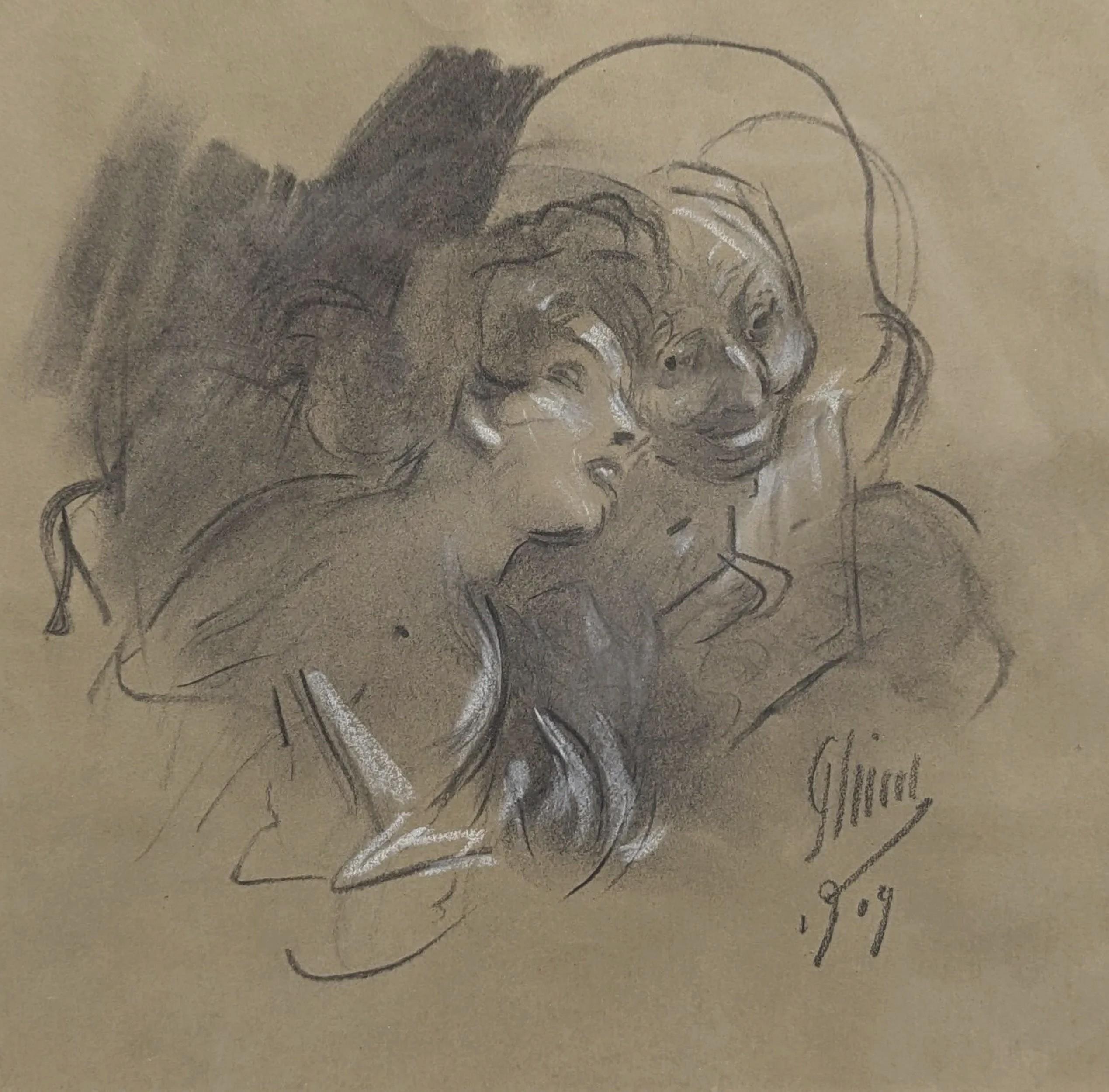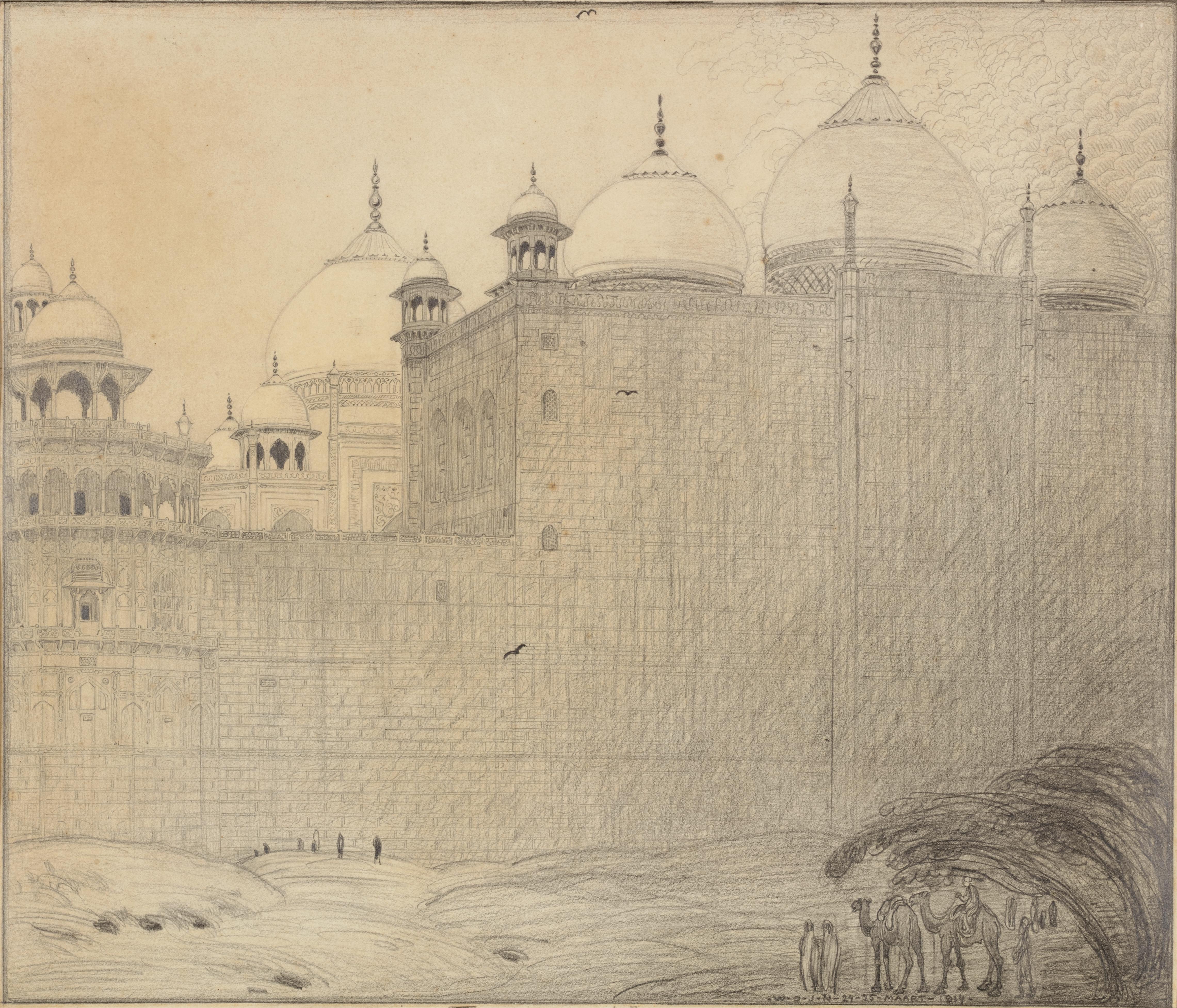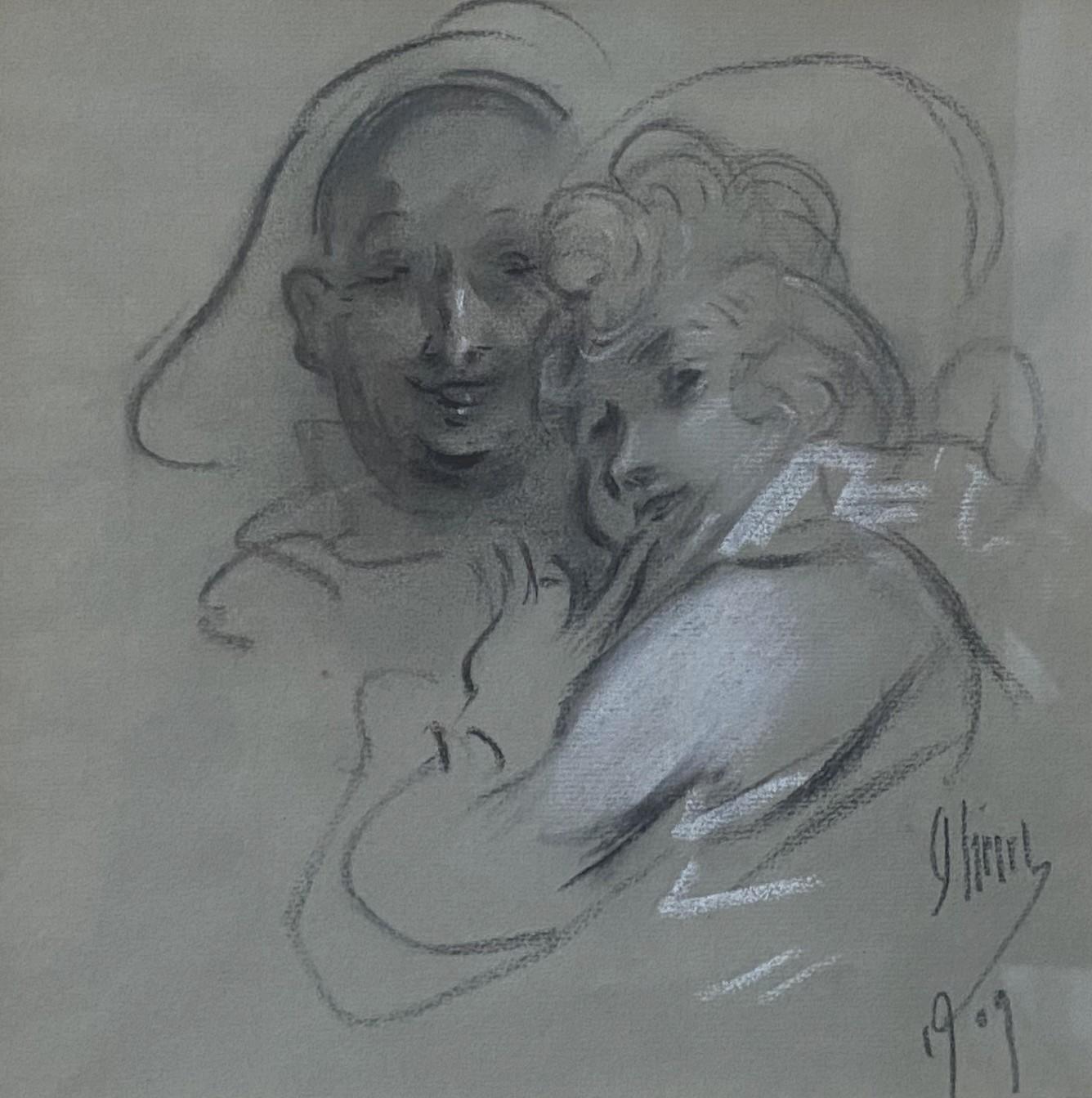Items Similar to Tea at the Ritz, New York
Want more images or videos?
Request additional images or videos from the seller
1 of 11
Paul César HelleuTea at the Ritz, New YorkCirca 1912
Circa 1912
About the Item
Tea at the Ritz, New York
Colored chalk, 1912
Signed with the estate stamp verso. (see photo)
Authenticated by the artist's daughter, Mme Paulette Johnston.
Image size: 10 5/8 x 10 1/4 inches
Frame size: 21-1/4 x 20-3/4 x 1-3/4"
Archival framing with Ultra violet filtration glass, 22K gold leaf frame, silk matting a gold bevel fillet
Provenance: Estate of the Artist
Mme. Paulette Johnston (his daughter)
Jane Robert Fine Arts, Paris
Condition: Excellent
Paul César Helleu was born in Vannes, Brittany, France. His father, who was a customs inspector, died when Helleu was in his teens. Despite opposition from his mother, he then went to Paris and studied at Lycée Chaptal. In 1876, at age 16, he was admitted to the École des Beaux-Arts, beginning academic training in art with Jean-Léon Gérôme. Helleu attended the Second Impressionist Exhibition in the same year, and made his first acquaintances with John Singer Sargent, James McNeill Whistler, and Claude Monet. He was struck by their modern, bold alla prima technique and outdoor scenes, so far removed from the studio. Following graduation, Helleu took a job with the firm Théodore Deck Ceramique Française hand-painting fine decorative plates. At this same time, he met Giovanni Boldini, a portrait painter with a facile, bravura style, who became a mentor and comrade, and strongly influenced his future artistic style.
When he was 18 years old, Helleu established a close friendship with John Singer Sargent, four years his senior, that was to last his lifetime. Already becoming established, Sargent was receiving commissions for his work. Helleu had not sold anything, and was deeply discouraged almost to the point of abandoning his studies. When Sargent heard this, he went to Helleu and picked one of his paintings, praising his technique. Flattered that Sargent would praise his work, he offered to give it to him. Sargent replied, "I shall gladly accept this, Helleu, but not as a gift. I sell my own pictures, and I know what they cost me by the time they are out of my hand. I should never enjoy this pastel if I hadn't paid you a fair and honest price for it." With this he paid him a thousand-franc note.
Helleu was commissioned in 1884 to paint a portrait of a young woman named Alice Guérin (1870–1933). They fell in love, and married on 28 July 1886. Throughout their lives together, she was his favourite model. Charming, refined and graceful, she helped introduce them to the aristocratic circles of Paris, where they became popular fixtures.
On a trip to London with Jacques-Émile Blanche in 1885, Helleu met Whistler again and visited other prominent artists. His introduction to James Jacques Tissot, an accomplished society painter from France who made his career in England, proved a revelation. In Tissot, Helleu saw, for the first time, the possibilities of drypoint etching with a diamond point stylus directly on a copper plate. Helleu quickly became a virtuoso of the technique, drawing with the same dynamic and sophisticated freedom with his stylus as with his pastels. His prints were very well received, and they had the added advantage that a sitter could have several proofs printed to give to relations or friends. Over the course of his career, Helleu produced more than 2,000 drypoint prints.
Soon, Helleu was displaying works to much acclaim at several galleries. Degas encouraged him to submit paintings to the Eighth Impressionist Exhibition in May and June 1886. The show was installed in a Paris apartment at 1 rue Laffitte, which ran concurrently with the official Salon that year to make a statement. Although 17 artists joined the famous exhibit that included the first Neo-Impressionistic works, Helleu, like Monet, refused to participate.
Paul Helleu Sketching with His Wife (1889), by John Singer Sargent, The Brooklyn Museum, New York
In 1886, Helleu befriended Robert de Montesquiou, the poet and aesthete, who bought six of his drypoints to add to his large print collection. Montesquiou later wrote a book about Helleu that was published in 1913 with reproductions of 100 of his prints and drawings. This volume remains the definitive biography of Helleu. Montesquiou introduced Helleu to Parisian literary salons, where he met Marcel Proust, who also became a friend. Proust created a literary picture of Helleu in his novel Remembrance of Things Past as the painter Elstir. (Later, Helleu engraved a well-known portrait of Proust on his deathbed.) Montesquiou's cousin, the Countess Greffulhe, enabled Helleu to expand his career as a portrait artist to elegant women in the highest ranks of Paris society, portraits that provide the basis for his modern reputation. His subjects included the Duchess of Marlborough, the Marchesa Casati, Belle da Costa Greene, Louise Chéruit, and Helena Rubinstein.
Looking for new inspiration, Helleu began a series of paintings and color prints of cathedrals and stained glass windows in 1893, followed by flower studies and landscapes of parks in Versailles. Helleu took up sailing, owning four yachts over his life. Ships, harbor views, life at port in Deauville, and women in their fashionable seaside attire became subjects for many vivid and spirited works.
In 1904, Helleu was awarded the Légion d'honneur and became one of the most celebrated artists of the Edwardian era in both Paris and London. He was an honorary member in important beaux-arts societies, including the International Society of Painters, Sculptors, and Engravers, headed by Auguste Rodin, and the Société Nationale des Beaux-Arts.
On his second trip to the United States in 1912, Helleu was awarded the commission to design was the ceiling decoration in New York City's Grand Central Terminal. He decided on a mural of a blue-green night sky covered by the starry signs of the zodiac that cross the Milky Way. Although the astrological design was widely admired, the ceiling was covered in the 1930s. It was completely restored in 1998.
Helleu made his last trip to New York City in 1920 for an exhibition of his work, but he realized that the Belle Époque was over. He felt out of touch, and shortly after his return to France, he destroyed nearly all of his copper plates and retired to family life. While planning for a new exhibition with Jean-Louis Forain, he died in 1927 at age 67 of peritonitis following surgery in Paris.
Among many of his friends was Coco Chanel, who chose beige as her signature colour upon on his advice—the colour of the sand on the beach of Biarritz in early morning.
Courtesy Wikipedia
- Creator:Paul César Helleu (1859-1927, French)
- Creation Year:Circa 1912
- Dimensions:Height: 10.625 in (26.99 cm)Width: 10.25 in (26.04 cm)
- Medium:
- Movement & Style:
- Period:
- Condition:Original condition, archival framing (see above description).
- Gallery Location:Fairlawn, OH
- Reference Number:
About the Seller
5.0
Recognized Seller
These prestigious sellers are industry leaders and represent the highest echelon for item quality and design.
Platinum Seller
These expertly vetted sellers are 1stDibs' most experienced sellers and are rated highest by our customers.
Established in 1978
1stDibs seller since 2013
711 sales on 1stDibs
Typical response time: 1 hour
Associations
International Fine Print Dealers Association
- ShippingRetrieving quote...Ships From: Fairlawn , OH
- Return PolicyA return for this item may be initiated within 10 days of delivery.
More From This SellerView All
- Double sided crayon drawing in colors: Study for "The Shoe" (recto)By Théophile Alexandre SteinlenLocated in Fairlawn, OHDouble sided crayon drawing: Front: Study for "The Shoe" Reverse: Studies of Figures Blue crayon, red and black crayons Image size: 19.25 x 15.375 inches Frame size: 30 x 25 1/2 inches Signed with the estate stamp, Lugt 2312b, recto and verso Annotated on verso in blue pencil: “On Demande des petites femmes...Category
1890s Art Nouveau Figurative Drawings and Watercolors
MaterialsCrayon
- Femme nue de dos allongeeBy Théophile Alexandre SteinlenLocated in Fairlawn, OHFemme nue de dos allongee Charcoal and white chalk on laid paper Signed in charcoal, lower right "Steinlen" (see photo) Note: Similar reclining nude drawing illustrated Slatkin No. 12 (See window on right) Similar drawing, same model, same media, Proute 1971, Catalog Dandre Bardon, no. 115 There also other similar finished drawings of nudes in similar poses and with the same couch, white blanket...Category
1920s French School Nude Drawings and Watercolors
MaterialsChalk, Charcoal
- The Infant Jupiter Nursing from the She-Goat Amaltheia (The Birth of Jupiter)By Luigi QuainiLocated in Fairlawn, OHThe Infant Jupiter Nursing from the She-Goat Amaltheia (The Birth of Jupiter) Red chalk and wash on off-white paper, c. 1700 Unsigned Attribuuted to Quaini by Dwight Miller, the sch...Category
18th Century and Earlier Baroque Figurative Drawings and Watercolors
MaterialsChalk
- Nu (Standing Female Nude)By Charles DespiauLocated in Fairlawn, OHSigned lower right by the artist Note: Despiau was a highly regarded sculptor. In his youth, he worked in the studio of Auguste Rodin, who greatly influenced his mature style. Hi...Category
1920s Nude Drawings and Watercolors
MaterialsChalk
- Head of a Woman (Margaret)By Leon KrollLocated in Fairlawn, OHHead of a Woman (Margaret) conte on wove paper, 1925 Signed and dated lower right Annotated "Margaret" in ink verso A portrait of Margaret Cassidy Manship ( d. 2012), daughter in law...Category
1920s Ashcan School Figurative Drawings and Watercolors
MaterialsConté
- CornucopiaBy Adolf Arthur DehnLocated in Fairlawn, OHSigned by the artist in ink lower right Preliminary sketch in reverse for the 1928 lithograph "Cornucopia," part of Dehn's Paris Lithographs portfolio An unsigned sketch of tw...Category
1920s Figurative Drawings and Watercolors
MaterialsInk
You May Also Like
- Entrance to the temple at Klungkung, Bali, 1925Located in Amsterdam, NLEntrance to the temple at Klungkung, Bali, 1925 With studio seal at the reverse, dated and described, bottom left Black chalk on paper, 53 x 46.5 cm In ebonized frame with white mount Willem Otto Wijnand Nieuwenkamp (1874-1950) Nieuwenkamp was born on July 27th 1874 in Amsterdam. His father owned sailing ships sailing to Indonesia and hearing the stories of the returning captains evoked in the young Nieuwenkamp an obsession for distant lands and adventure. After a failed attempt by his father to have his son make a career in his business, Nieuwenkamp attended the Academy for Decorative Art in Amsterdam. However, he left within one year to go his own way. He was an autodidact and a great experimenter with new techniques, particularly in the art of etching. Nieuwenkamp was a very focused man with the discipline of a scientist tempered by the sensitivity of an artist, a lust for adventure, a natural appreciation for ethnic arts and an enormous ambition to tread new paths. In 1898 he visited Indonesia for the first time and on his second visit in 1903-1904 he went on to Bali and became the first foreign artist to love Bali and the Balinese with a passion. Having secured agreements with several museums in the Netherlands to obtain Balinese art...Category
1920s Art Nouveau Landscape Drawings and Watercolors
MaterialsPaper, Chalk
- Jules Cheret (1836-1932) La Confidence, 1909, drawing signedBy Jules ChéretLocated in Paris, FRJules Cheret (1836-1932) La Confidence (The confidence) 1909 signed and dated in the lower right Charcoal and heightenings of white chalk 22.7 x 22.7 cm Framed under glass : 33.8 x...Category
Early 1900s Art Nouveau Figurative Drawings and Watercolors
MaterialsChalk, Charcoal
- Frank Brangwyn Painting Mural Study Christ's Hospital West Horsham England 1912By Sir Frank BrangwynLocated in Portland, ORFRANK BRANGWYN ( U.S./U.K./Belgium, 1867-1956) watercolor, gouache, and charcoal on paper, "The Scourging of St. Alban," study for the mural painted for Christ's Hospital, West Horsh...Category
1910s Art Nouveau Figurative Paintings
MaterialsChalk, Charcoal, Watercolor, Gouache, Pencil
- Part of the ring-wall of the Taj Mahal, Agra, India, 1914Located in Amsterdam, NLPart of the ring-wall of the Taj Mahal, Agra, India, 1914 Signed with initials and dated bottom right Black chalk on paper, 45.5 x 53 cm Literature: Ernst Braches en J.F. Heijbro...Category
1910s Art Nouveau Landscape Drawings and Watercolors
MaterialsChalk, Paper
- Jules Cheret (1836-1932) A couple, 1909, drawing signedBy Jules ChéretLocated in Paris, FRJules Cheret (1836-1932) A couple, 1909 signed and dated in the lower right Charcoal and heightenings of white chalk 23 x 23 cm Framed under glass : 33.8 x 33.8 cm This work is hi...Category
Early 1900s Art Nouveau Figurative Drawings and Watercolors
MaterialsCharcoal, Chalk
- Statue of Vishnu Garuda, Bali, 1904Located in Amsterdam, NLStatue of Vishnu Garuda, Bali, 1904 Signed with initials Pencil and ink on paper, 21.4 x 21.3 cm Literature: Bruce W. Carpenter, W.O.J. Nieuwenkamp. First European Artist in Bali,...Category
Early 1900s Art Nouveau Landscape Drawings and Watercolors
MaterialsPaper, Pencil, India Ink
Recently Viewed
View AllMore Ways To Browse
Green Glass Leaf Plates
Johnston Sign
Lady Paris Watercolor
Johnston Sign
Istanbul Watercolor
John A Dunn
Red Grouse
Reeves Design Louis
Moon Jar Drawing
Sanne Bleka
The Dear Hunter
Richard Clague
Robert F Butts
Polo Player Art
Set Of Fashion Designer Drawings
Fashion Designer Drawings
Henry Urban
1930s Animal Lithographs





